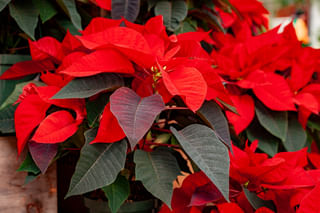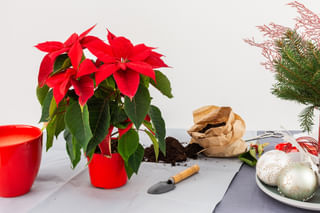The ultimate plant care guide for the Euphorbia pulcherrima (Poinsettia)

Are you looking to take care of a Euphorbia pulcherrima, also known as the Poinsettia? This guide will help you understand the key aspects of proper care for a Euphorbia pulcherrima.
The Poinsettia is a beautiful plant consisting of bright red or yellow flower bracts, which are modified leaves that give it its characteristic shape and vibrant color. Despite its delicate appearance, it’s actually quite easy to care for and maintain.
To give you the best chance to take care of this plant, I've broken down the caring process into a few different steps. These steps give you the most in-depth information to teach you everything you need to know about caring for your plant.
-
How to care for a Euphorbia pulcherrima (Poinsettia)
1
. How to care for a Euphorbia pulcherrima (Poinsettia)
Back to the top
Learn how to care for a Euphorbia pulcherrima (Poinsettia) houseplant and get it blooming year after year. Get tips on providing the ideal lighting, watering, and fertilizing conditions for this unique houseplant! Perfect guide for both experienced gardeners and beginner plant owners.
Read "How to care for a Euphorbia pulcherrima (Poinsettia)"
In this ultimate guide to taking care of an Poinsettia, we'll look at the best sunlight exposure, the ideal watering schedule, how often you should fertilize it, and much more.
Let's dive right in and learn how we can take care of our Poinsettia throughout the year!
Scientific classification of Euphorbia pulcherrima
Plants go by many names, but it can become confusing very quickly if you're talking about different plants with the same nickname. That's why I'm including the scientific name of the plant, so we're all on the same page!
|
Classification
|
Name
|
|
Species
|
Euphorbia pulcherrima |
Frequently asked questions
How should you water the Euphorbia pulcherrima (Poinsettia)?
The Euphorbia pulcherrima (Poinsettia) likes to be watered occasionally, but also needs to soil to dry out slightly. Water when the top of the soil has dried out.
How much sunlight does the Euphorbia pulcherrima (Poinsettia) need?
The Euphorbia pulcherrima (Poinsettia) does best in a spot where it gets bright, indirect sunlight. This spot is always bright but never gets direct sunlight.
How much fertilizer does the Euphorbia pulcherrima (Poinsettia) need?
The Euphorbia pulcherrima (Poinsettia) needs quite a bit of energy to grow, so you should fertilize it once per month in the spring and summer.
What is the best soil for the Euphorbia pulcherrima (Poinsettia)?
The Euphorbia pulcherrima (Poinsettia) likes to be watered when the top of the soil is dry, so use a soil mix that drains excess moisture quickly and holds onto some moisture for a few days.
What is the ideal temperature for the Euphorbia pulcherrima (Poinsettia)?
The Euphorbia pulcherrima (Poinsettia) prefers a spot that consistently stays between 18 - 27°C (64 - 80°F).
How do you propagate the Euphorbia pulcherrima (Poinsettia)?
To propagate the Euphorbia pulcherrima (Poinsettia), you can take cuttings from the parent plant. Often, you cut part of the stem of the Euphorbia pulcherrima (Poinsettia) and plant that in moist soil.
How often should you repot the Euphorbia pulcherrima (Poinsettia)?
You should repot your Euphorbia pulcherrima (Poinsettia) once every 1 year(s). This helps your Euphorbia pulcherrima (Poinsettia) to stay healthy for many years.
Is the Euphorbia pulcherrima (Poinsettia) easy to take care of?
The Euphorbia pulcherrima (Poinsettia) is not the best plant for beginners, but also not very difficult to take care of.
Didn't find what you were looking for?
We have resources about other plants and plant-related topics as well.
Perhaps these resources contain the information you're looking for.
I've written a lot of guides about all kinds of aspects of taking care of plants, but I could've missed that specific topic you were looking for. If that's the case, you can request a plant guide. This way I can provide you with the information you need quickly and you won't have to wonder if you're taking care of your plant properly anymore.


